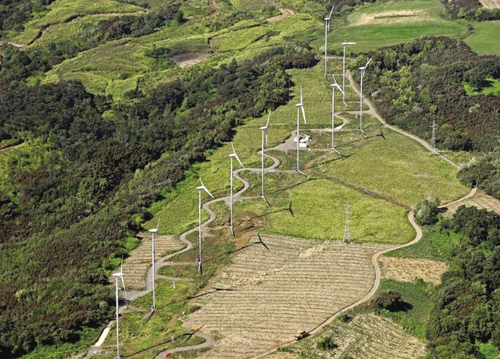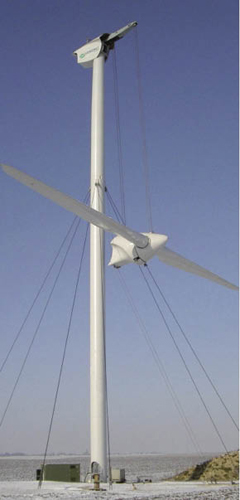
Vergnet says its two-bladed turbine works with good efficiency while the lowering system provides protection from hurricanes.
It’s no secret that many wind-turbine models can’t handle the stress of extreme weather. There have even been instances in which wind turbines have exploded or crumbled in harsh storms. With this in mind, one OEM set out to create a hurricane-proof wind turbine. Vergnet SA (www.vergnet.com) says its GEV HP two-bladed turbine can withstand hurricane winds up to category 5.
With the onset of harsh weather, the company says the 1MW turbine’s upwind nacelle and rotor blades can be lowered to a ground-level platform. The lowering system ensures all components are secured in a brief period and allows for ground-level maintenance. Vergnet says the system’s convenience reduces operating costs and maintenance downtimes, adding to the turbine’s availability and profitability.
By letting six guy wires balance the 70-m turbine tower, designers were able to trim 33% off its weight. The steel and polyethylene wires are anchored into a relatively small amount of concrete – two-thirds less than most conventional 1MW turbines. The turbine is equipped with a fastening system, similar to one found in suspension bridges to ensure safety in harsh weather.

The GEV HP easily lowers the blades and nacelle onto a landing platform allowing for ground-level maintenance and repairs, says the company.
A heavy-duty nacelle cover protects the inner components. The company says a proprietary teetering hub helps reduce load fluctuations and stress from wind turbulence by 35%. The nacelle also houses an all-weather generator for extreme weather conditions and a cooled three-stage gearbox. An additional varnish coat is applied on electronic components to combat condensation.
What’s more, the two-bladed, 62m rotor is easier to lower and secure than if it were a three-bladed rotor for a similar rating, says the company. The blades are manufactured through vacuum infusion. In this process, composite fiber mats are placed in a mold and are vacuum-infused with composite through a pump and hose system. The infusion produces a wider, thicker blade that increases bending resistance by removing air pockets in the laminate.
Vergnet’s light structure extends climate protection and offers new possibilities for locations not previously known as wind-turbine friendly. It is considered a cost-effective installation because it ships in 40-ft. standard containers and is self-erecting using an integrated erection tool. The company adds that its turbine complies with many international grid codes, such as EON, REE, AEMCO, and easily integrates into any grid. WPE
Filed Under: News, Turbines




